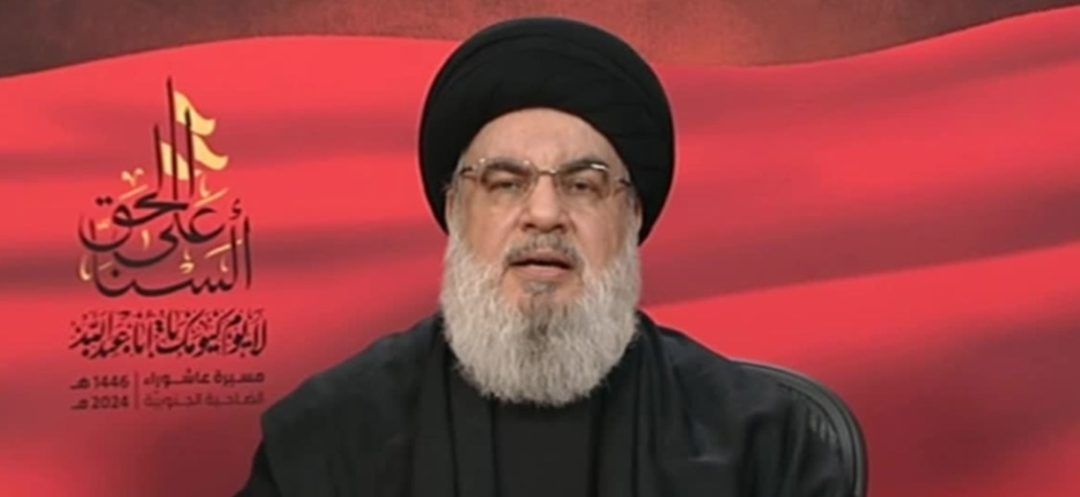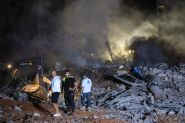- Home
- War in the Middle East
- Hezbollah's Chief Hassan Nasrallah, A Central Figure in Lebanon's Political Landscape

A central figure in the Lebanese political landscape and Hezbollah's Secretary General since 1992, Hassan Nasrallah was born on August 31, 1960 in the Chrarchbouk district, near Quarantina. Born into a modest family hailing from the South Lebanese village of Bazouriyé, he was the eldest of nine siblings.
After the outbreak of the Lebanese civil war in 1975, his family returned to their native village, fleeing the fighting in Beirut. Young Hassan began to take an interest in politics, joining the ranks of the Amal movement, founded by Imam Moussa Sadr.
However, he left Lebanon a year after the start of the conflict to study theology in the theological schools of Najaf, the “Mecca” of Shiite Islam in Iraq. There, Nasrallah met the future leader of Iran's Islamic revolution, Ayatollah Rouhollah Khomeini, through his mentor, the Shiite cleric Abbas al-Moussawi, who would later precede him as head of Hezbollah.
When Israel invaded Lebanon in 1982, Nasrallah had returned home after four years in Iraq, fleeing repression under Saddam Hussein's regime. Al-Moussawi encouraged his students to join the new “Islamic resistance in Lebanon” set up by the Islamic Revolutionary Guard Corps (IRGC), by setting himself as an example.
Opposed to Nabih Berri's growing power within the Amal movement and its secularization, Nasrallah followed suit and joined the organization, laying the foundations for the pro-Iranian group. Three years later, in 1985, the creation of Hezbollah was made official: a movement explicitly claiming allegiance to the Iranian Islamic Revolution and its ideology, the Velayat-e-faqih.
Nasrallah quickly climbed Hezbollah’s ranks, thanks to his commitment and oratory skills. He was initially put in charge of the organization's activities in Beirut. According to historians Dominique Avon and Anaïs-Trissa Khatchadourian, he became a member of the organization's decision-making council and head of its executive board in 1987.
Little is known about his role over the next five years, except that he spent a year in Qom, Iran.
In February 1992, following the assassination of Abbas al-Moussawi in an Israeli raid, Nasrallah took over the leadership of the movement. His appointment marked a turning point for Hezbollah, then mainly a militia fighting the Israeli occupation of southern Lebanon.
Under his leadership, the movement evolved into a more structured and influential politico-military organization. In 1998, he was re-elected head of the organization, after amending a party clause that limited the number of terms of office of the Secretary General to two.
One of the group’s major achievements under Nasrallah’s leadership was the withdrawal of Israeli forces from southern Lebanon in 2000, after almost two decades of occupation.
This event, seen by much of the Arab world as a historic victory against Israel, boosted Nasrallah's popularity in Lebanon and the region. An aura that was reinforced by the death of his son in a skirmish with the Israeli army in 1997.
He has also established himself as a key political player in the complex Lebanese political system, where Hezbollah has become a force to be reckoned with, with seats in parliament and considerable influence within government coalitions.
Nasrallah has also strengthened Hezbollah's relations with Iran, its main financial and military supporter. This link with Teheran has enabled the movement to develop sophisticated military capabilities, which were evident in its direct confrontations with Israel, notably in the July 2006 war.
Although the conflict resulted in massive destruction in Lebanon, Nasrallah dubbed the 34-day war as a “divine victory” and managed to maintain an image of heroic resistance in the eyes of many Lebanese, particularly beyond the Shiite community.
Since then, Nasrallah has lived in hiding for fear of assassination, while continuing to address his supporters regularly via televised speeches. His last public appearance was on October 12, 2016, during celebrations for Achoura.
Outside Lebanon, Nasrallah has also become an influential regional player. Hezbollah played a decisive role in the Syrian civil war, providing military support to Bashar al-Assad's regime.
However, this stance has divided Lebanese public opinion, with some seeing the intervention as an extension of the fight against Israel and “the American-Zionist imperialist project”, while others saw it as an interference that exacerbated the country's sectarian divisions, notably between Sunnis and Shiites. Internationally, this has led him to lose sympathy in the Arab world.
Despite his popularity among some Lebanese Shiites and other Arab communities, Nasrallah remains a controversial figure on the international stage. Hezbollah is classified as a terrorist organization by several Western countries, notably the United States and the European Union, while his supporters see him as a leader of the resistance against “Israeli occupation and Western imperialism”.
On the Lebanese political scene, he remains best known for his policy of systematically obstructing state institutions to serve his goals. The election of a president is the latest example of this, with Nasrallah employing every possible means to support his candidate. In other words, the Hezbollah leader has demonstrated his willingness to do anything to achieve his goals, even if it means dragging Lebanon down with him.
After the outbreak of the Lebanese civil war in 1975, his family returned to their native village, fleeing the fighting in Beirut. Young Hassan began to take an interest in politics, joining the ranks of the Amal movement, founded by Imam Moussa Sadr.
However, he left Lebanon a year after the start of the conflict to study theology in the theological schools of Najaf, the “Mecca” of Shiite Islam in Iraq. There, Nasrallah met the future leader of Iran's Islamic revolution, Ayatollah Rouhollah Khomeini, through his mentor, the Shiite cleric Abbas al-Moussawi, who would later precede him as head of Hezbollah.
When Israel invaded Lebanon in 1982, Nasrallah had returned home after four years in Iraq, fleeing repression under Saddam Hussein's regime. Al-Moussawi encouraged his students to join the new “Islamic resistance in Lebanon” set up by the Islamic Revolutionary Guard Corps (IRGC), by setting himself as an example.
Opposed to Nabih Berri's growing power within the Amal movement and its secularization, Nasrallah followed suit and joined the organization, laying the foundations for the pro-Iranian group. Three years later, in 1985, the creation of Hezbollah was made official: a movement explicitly claiming allegiance to the Iranian Islamic Revolution and its ideology, the Velayat-e-faqih.
Nasrallah quickly climbed Hezbollah’s ranks, thanks to his commitment and oratory skills. He was initially put in charge of the organization's activities in Beirut. According to historians Dominique Avon and Anaïs-Trissa Khatchadourian, he became a member of the organization's decision-making council and head of its executive board in 1987.
Little is known about his role over the next five years, except that he spent a year in Qom, Iran.
In February 1992, following the assassination of Abbas al-Moussawi in an Israeli raid, Nasrallah took over the leadership of the movement. His appointment marked a turning point for Hezbollah, then mainly a militia fighting the Israeli occupation of southern Lebanon.
Under his leadership, the movement evolved into a more structured and influential politico-military organization. In 1998, he was re-elected head of the organization, after amending a party clause that limited the number of terms of office of the Secretary General to two.
One of the group’s major achievements under Nasrallah’s leadership was the withdrawal of Israeli forces from southern Lebanon in 2000, after almost two decades of occupation.
This event, seen by much of the Arab world as a historic victory against Israel, boosted Nasrallah's popularity in Lebanon and the region. An aura that was reinforced by the death of his son in a skirmish with the Israeli army in 1997.
He has also established himself as a key political player in the complex Lebanese political system, where Hezbollah has become a force to be reckoned with, with seats in parliament and considerable influence within government coalitions.
Nasrallah has also strengthened Hezbollah's relations with Iran, its main financial and military supporter. This link with Teheran has enabled the movement to develop sophisticated military capabilities, which were evident in its direct confrontations with Israel, notably in the July 2006 war.
Although the conflict resulted in massive destruction in Lebanon, Nasrallah dubbed the 34-day war as a “divine victory” and managed to maintain an image of heroic resistance in the eyes of many Lebanese, particularly beyond the Shiite community.
Since then, Nasrallah has lived in hiding for fear of assassination, while continuing to address his supporters regularly via televised speeches. His last public appearance was on October 12, 2016, during celebrations for Achoura.
Outside Lebanon, Nasrallah has also become an influential regional player. Hezbollah played a decisive role in the Syrian civil war, providing military support to Bashar al-Assad's regime.
However, this stance has divided Lebanese public opinion, with some seeing the intervention as an extension of the fight against Israel and “the American-Zionist imperialist project”, while others saw it as an interference that exacerbated the country's sectarian divisions, notably between Sunnis and Shiites. Internationally, this has led him to lose sympathy in the Arab world.
Despite his popularity among some Lebanese Shiites and other Arab communities, Nasrallah remains a controversial figure on the international stage. Hezbollah is classified as a terrorist organization by several Western countries, notably the United States and the European Union, while his supporters see him as a leader of the resistance against “Israeli occupation and Western imperialism”.
On the Lebanese political scene, he remains best known for his policy of systematically obstructing state institutions to serve his goals. The election of a president is the latest example of this, with Nasrallah employing every possible means to support his candidate. In other words, the Hezbollah leader has demonstrated his willingness to do anything to achieve his goals, even if it means dragging Lebanon down with him.
Read more



Comments